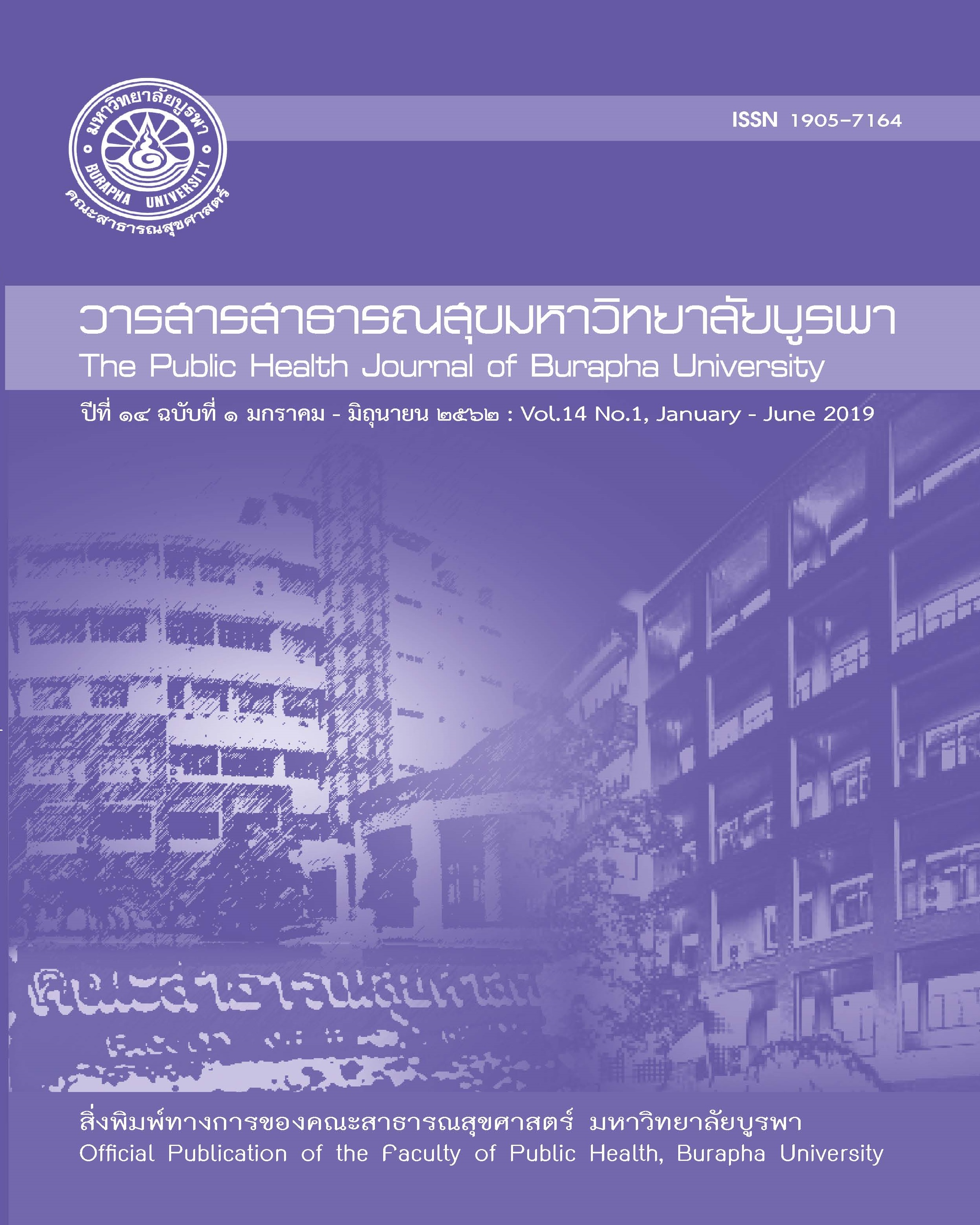การประเมินผลสำเร็จของการใช้พลาสมาเย็นแบบสัมผัสในการฟื้นฟูสภาพผิว
Main Article Content
บทคัดย่อ
Evaluation of the Effectiveness of a Contact-typed Cold Plasma for Skin Treatment
การวิจัยเชิงทดลองทางคลินิกมีวัตถุประสงค์เพื่อประเมินผลสำเร็จของการใช้พลาสมาเย็นแบบสัมผัสในการฟื้นฟูสภาพผิวหนังที่เกิดลักษณะผิวที่ไม่พึงประสงค์เนื่องจากการเสื่อมสภาพตามวัย ซึ่งสามารถมองเห็นได้ด้วยตาเปล่า ได้แก่ การลดลงของความยืดหยุ่นผิว การมีริ้วรอยเหี่ยวย่น ความไม่เรียบเนียนของผิว ความหมองคล้ำของสีผิว โดยศึกษากลุ่มตัวอย่างจำนวน 60 คน ที่มีอายุระหว่าง 40 – 80 ปี แบ่งเป็น 2 กลุ่ม กลุ่มที่หนึ่งใช้พลาสมาเย็นแบบสัมผัสเพียงอย่างเดียว จำนวน 30 คน กลุ่มที่สองใช้พลาสมาเย็นแบบสัมผัสร่วมกับครีมบำรุงผิวหน้าสมุนไพร “เอมบลิกาพลัส” จำนวน 30 คน อาสาสมัครทั้งสองกลุ่มได้รับการฟื้นฟูบริเวณใบหน้าและลำคอ นาน 15 นาที สัปดาห์ละ 1 ครั้ง ติดต่อกันเป็นเวลา 12 สัปดาห์ และติดตามผลในสัปดาห์ที่ 13 พบว่า อาสาสมัครทั้ง 2 กลุ่ม มีสภาพผิวหน้าค่อยๆดีขึ้นทุกสัปดาห์ โดยลักษณะผิวหน้าที่เห็นการเปลี่ยนแปลงได้ชัดเจนอย่างมีนัยสำคัญ (p – value < 0.05) คือ ความยืดหยุ่นผิว ริ้วรอย ความเรียบเนียน ความขาว และสภาพผิวโดยรวม และเมื่อทำการเปรียบเทียบระหว่างกลุ่มพบว่ากลุ่มที่ใช้พลาสมาแบบสัมผัสร่วมกับครีมบำรุงผิวเอมบลิกาพลัสมีประสิทธิภาพในการฟื้นฟูดีกว่ากลุ่มที่ใช้พลาสมาแบบสัมผัสเพียงอย่างเดียวทุกด้าน ยกเว้น ประสิทธิภาพในการฟื้นฟูด้านริ้วรอยให้ผลการรักษาไม่แตกต่างกัน สามารถสรุปได้ว่าพลาสมาเย็นแบบสัมผัสช่วยฟื้นฟูสภาพผิวที่ไม่พึงประสงค์ และเพิ่มการซึมผ่านของสารที่ใช้ทาบนผิวหนัง ทำให้ผลสำเร็จในการฟื้นฟูดียิ่งขึ้น การศึกษาวิจัยในครั้งต่อไปควรเพิ่มเครื่องมือที่ทันสมัยในการตรวจวัดสภาพผิว เช่น เครื่องทดสอบความยืดหยุ่นผิว เครื่องวัดความมันผิว เครื่องวัดปริมาณเม็ดสี เครื่องวัดความชุ่มชื้นผิว เพื่อเพิ่มประสิทธิภาพและความแม่นยำในการแปรผล
This clinical trial study aimed to evaluate the effectiveness of contact-typed cold (non-thermal) plasma, on repairing skin problems with the naked eye, such as, skin elasticity, wrinkles, rough skin and darkness of the skin color. 40-80 years old volunteers, were divided into 2 groups, 30 each. The first group received contact-typed cold plasma application only and the second group received contact-typed cold plasma application after applying “Emblica plus” herbal cream. In both groups, contact-typed cold plasma were applied for 15 minutes once a week for 12 weeks on skin over face and neck. The results showed that at 13th week, in both groups, the face conditions gradually better compared with before treatment.The skin elasticity, wrinkles, smoothness, brightness and overall skin conditions were significantly changed (p – value < 0.05) compared with before treatment. In addition, after compared between groups, it were founded that contact-typed plasma application after applying “Emblica plus” cream was better contact-typed cold plasma application in most of skin conditions. In spite of, effectiveness of wrinkles reduction was not different. Therefore, contact-typed cold plasma treatment resulted in typical skin problems improvement and one could expect on cream absorption ability into skin layer by the device. To improve of efficiency and accuracy, next experiment have to use more advance technology measuring instruments such as Cutometer, Sebumeter, Mexameter, Coneometer.
Article Details
References
2. Max Planck Institute for Extraterrestrial Physic. ข้อเสนอโครงการของ Max Planck Institute for Extraterrestrial Physic. [เข้าถึงเมื่อ 29 พฤษภาคม 2557]. เข้าถึงได้จาก https://www.mpe.mpg.de/2169/en.
3. Anderson L. Sydney: AMPCO; 2006. Looking good, the Australian guide to skin care, cosmetic medicine and cosmetic surgery.
4. Stefanaki C, Stratigos A, Katsambas A. Topicalretinoids in the treatment of Photoaging. J. Cosmet Dermatol 2005 ;4(2):130-134.
5. Kilmer S, Semchyshyn N, Shah G, Fitzpatrick R. A pilot study on the use of a plasma skin regeneration device (Portrait® PSR 3) in full facial rejuvenation procedures. Lasers in medical science 2007; 22 (2), 101-109.
6. ชาญชัย ฉัตรสิริมงคล และคณะ. การใช้เทคโนโลยีแนวใหม่ในการรักษาสุขภาพผิวพรรณ.กรุงเทพฯ:สำนักส่งเสริมและถ่ายทอดเทคโนโลยี; 2556.
7. พรชนก ต้นประดู่. (9 มกราคม 2556). สืบค้นเมื่อวันที่สืบค้นเมื่อวันที่ 4 มิถุนายน 2557, จาก https://www.clinictech.most.go.th/online/pages/ techlist_display.asp?tid=944.
8. สุภาภรณ์ ปิติพร และคณะ.โครงการศึกษาประสิทธิผลและความปลอดภัยของครีมบำรุงผิวหน้า “เอมบลิก้าพลัส”. ปราจีนบุรี:มูลนิธิโรงพยาบาลเจ้าพระยาอภัยภูเบศร; 2555.
